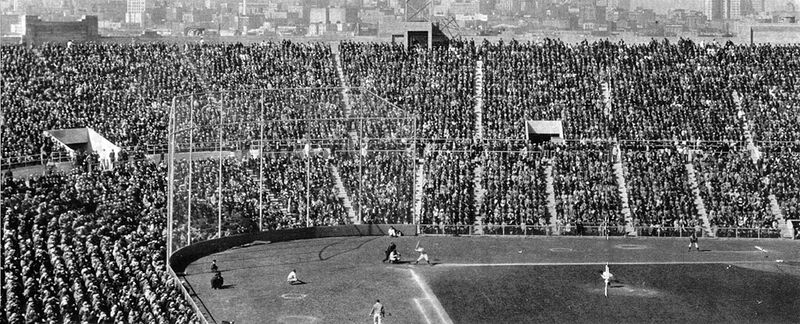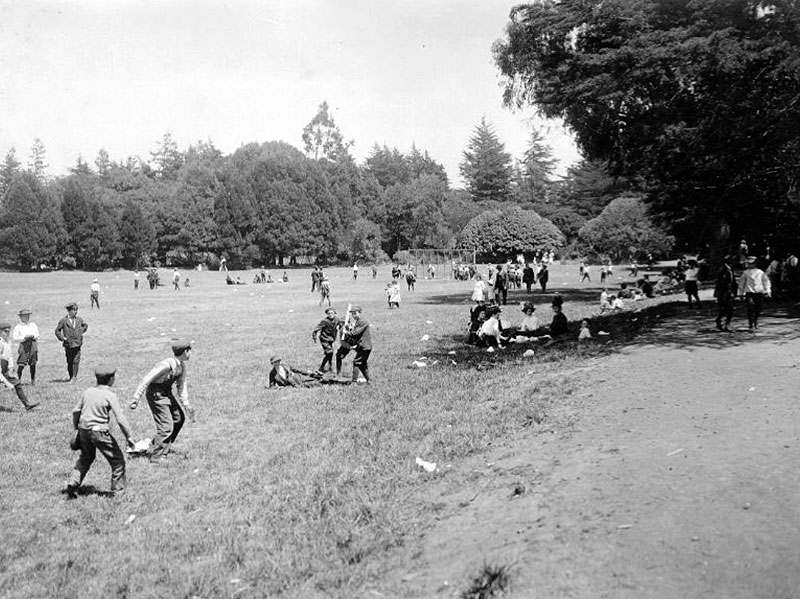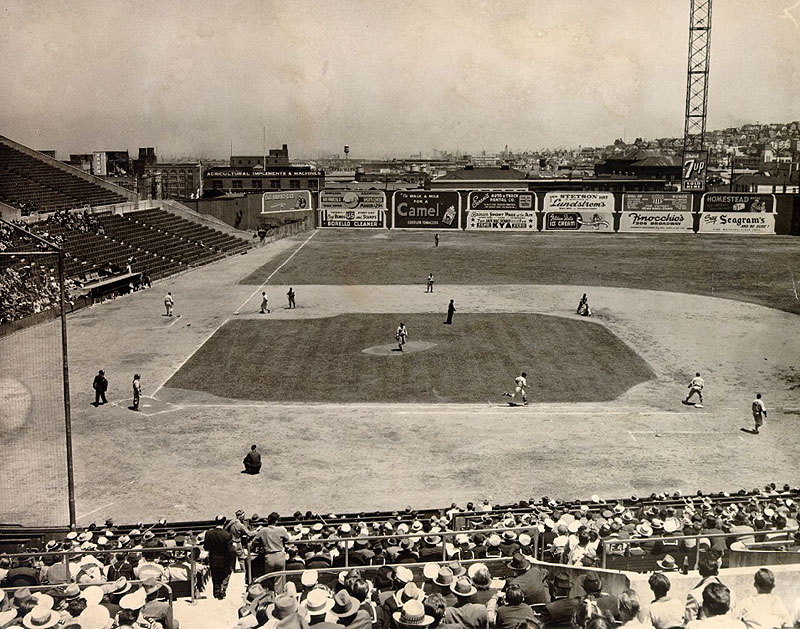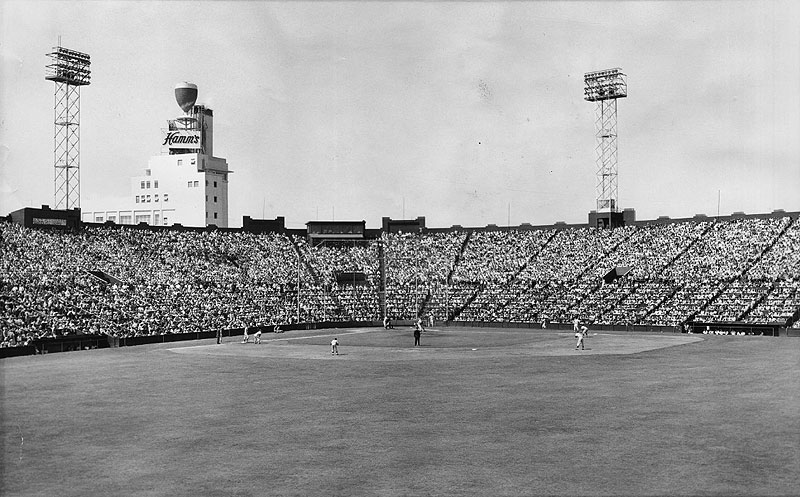Seals Are Born
Historical Essay
by Angus Macfarlane
Seals Stadium at 16th and Bryant, peering over left field wall to city center skyline in background, March 30, 1949.
Photo: San Francisco History Center, SF Public Library
In baseball’s early years (including Major League Baseball), there was no hard and fast rule about teams’ names. Brooklyn’s team was variously the Grays, the Trolley Dodgers, the Bridegrooms, and the Robbins before settling down as simply the Dodgers we all hate so much. The Chicago Cubs were variously called the Colts, the Orphans, and the Caps. Only much, much later were teams required to pick a name a stick with it. The same applied to minor league teams. From season to season, names changed, possibly named for the color of their apparel, or the name of the manager or of a popular player. This looseness was common but not a problem.
On March 14, 1903, The NATIONAL BASEBALL CLUB OF SAN FRANCISCO was incorporated. This was the official corporate/business name of the San Francisco “nine”. But no nickname.
On March 26, 1903, the new Pacific Coast League was baptized before 7,000 congregants at Recreation Park at 8th and Harrison streets with the San Francisco franchise dueling Portland’s entry. The “home team’s” uniform spelled out SAN FRANCISCO across the jersey.
The Call’s report of the game referred to the home team as “THE HOME TEAM”. The Chronicle dubbed them the “STARS”. The Examiner couldn’t do any better than “THE LOCAL FAVORITES”.
Interestingly (and forgotten by history) there were two competing minor leagues for most of the 1903 season in San Francisco. The PCL snatched two teams from the extant Pacific Northwest League, Seattle and Portland, effectively starting a baseball war. While the PCL’s San Francisco club, along with Oakland’s club, played at 8th and Harrison, the rival (and renamed) Pacific National League played at 9th and Bryant, currently Trader Joe’s and recently the Bed, Bath and Beyond outlet.
By July 4, 1903, the Chronicle was using “Harris’ Hired Men,” a reference to the popular manager Henry Harris. The Call called the home team “Uncle” on the 4th, but not in tribute to Uncle Sam. Again a reference to “Uncle” Harris. Additionally, “Home Team” and “San Francisco Team” were used. “Harris’ Men” was the best the Examiner could come up with.
The 1903 season ended on November 4 with “Uncle’s Dilapidated Gathering” (Call), “Friscans” (Examiner), and “Locals” (Chronicle) defeating Portland 4-3 to finish the first PCL season with a record of 98-102 and a 4th place finish. Throughout the season there was no consistency or consensus among the local papers or by the individual papers from game to game regarding what to call the men who played the national pastime at 8th and Harrison.
A very popular pastime in San Francisco, here are people playing baseball in Golden Gate Park at the turn of the 20th century.
Photo: San Francisco History Center, SF Public Library
1904 began with “Uncle’s Team,” “Harris’ Men” (Chronicle), “Uncle’s Men” (Examiner), and “San Francisco” (Call) attired in crisp white unis with black trim defeating Seattle 1-0 on March 25. During the first week of the season, the 8th and Harrison Street boys were called Uncle’s Stars, Native Tossers, Locals, Uncle’s Constellation, Uncle’s Bunch, San Francisco, and Gentlemen of This Side of The Bay.
ENOUGH! proclaimed the Bulletin. On March 30, it headlined:
Suitable Nickname Wanted for San Francisco’s Baseball Nine
To that end, the Bulletin announced a contest for the best name, the winner to be awarded a pass for the upcoming season. The contest would close on April 9. The Bulletin offered its columns for the publication of the “most appropriate, the neatest, the most pat, and catchy names” suggested by the fans. “An excellent committee” was empaneled, composed of Superior Court Judge Thomas Graham (chairman), former San Francisco and Major League star William Lange, and Danny Long, a popular California League player from the 1890s. The format was that after the end of submissions, the judges would then select 12 finalists, from which each judge would then select two names.
Expressing the pulse of the fan: “there is no dissenting voice on the question that a suitable and lasting name should be chosen. Who has not heard of the St. Louis Browns, the New York Giants, the Cincinnati Reds, the Quakers, the Pirates, the Senators, the Brewers of Milwaukee and the Cowboys of Kansas City? And who ever has heard the San Francisco team called by a nickname that would be recognized by a fan in any part of the United States east, west, north, and south?
Low attendance at Seals Stadium, December 20, 1945.
Photo: San Francisco History Center, SF Public Library
As the suggestions began to come in, the Bulletin published them. First day returns included: Vigilantes, Lions, Seals, 49ers, 7 Hills, Sand Lotters, Hoboes, Cheese Cakes, Orientals, Frisky Friscos, Hooligans, Alcades, Sunsets, Whimsicals, Qualities, Parisians, Nickel-Squeezers, Fan-Tans, Tobacconists, Fleas, Padres, Pig Tails, Hot Tamales.
On April 2 the Bulletin updated: BASEBALL CONTEST GROWS MORE FURIOUS.
April 3’s update: “Hundreds are trying hard to win coveted prize.”
April 6: BASEBALL CONTEST DRAWING TO CLOSE. Only Three More Days Remain and Very Few Good Nicknames Have Been Offered.
Hundreds of letters have been received, but most of them contain the stupidest, silliest kinds of nicknames. Fans that cannot offer better suggestions than PIKERS, BEAUTIES, TIGERS, LOBSTERS, or DAISIES, FAIRIES, PETS should save their time and stamps. Names that are labeled SAN FRANCISCO or FRISCO are thrown out. The nickname is required to be significant in some way of this city.
While the suggestions were pouring in, the sports writers continued with their ad hoc appellations: Uncle Harris’ Team, Frisco’s, Stars, Uncle’s Star Aggregation, the Home Team, Bay City Men, Uncle Harris’ Fog Biters, Harris’ Men, Hank Harris’ Sluggers, Undertakers, Medicine Men.
Crowds entering Seals Stadium on 16th at Bryant, 1940s.
Photo: San Francisco History Center, SF Public Library
BASEBALL CONTEST WILL TERMINATE TOMORROW. Judges Have Digested Hundreds of Letters, and Have Chosen Six.
Nearly 2,000 letters were received containing from one to a score of names. Many names were sent in over and over again. Quite a number were too silly or too stupid to warrant publication. The Bulletin reiterated: “Scores of contestants overlooked the important feature that the contest was not to find a nickname for this year’s nine, but to secure one that would be suitable for the players on the San Francisco team this year, next year, or ten years from now.”
The Bulletin printed about 100 of the suggestions ranging from A (Adobes & Alohas) to Z (Zephyrs). The first stage of elimination was to select 12 semi-finalists. These were: Seals, Golden Gates, Nephews, Hill Climbers, Fog Eaters, Friars, Sea Lions, Vigilantes, Argonauts, Coiners, Peninsulars, and Cosmopolitans. Next, each judge chose two from the semi-finalists. This was boiled down to five. (One name was chosen by two judges): Seals, Golden Gates, Nephews, Fog Eaters and Sea Lions. Fog Eaters was eliminated because it was deemed to be a “knock” against San Francisco, and Sea Lions because it was too similar to Seals.
The final three were: Seals, Golden Gates, and Nephews (an homage to the manger, “Uncle” Henry Harris). At the next round two judges voted against Golden Gates because it was commonly used by “minor teams” in the area. Two judges then chose Seals and one preferred Nephews. Seals it was.
Seals had been suggested many times, but the first submission (on the first day) by William J Carroll was the winner.
The first paper to publish the team’s new nickname is a game account was the Chronicle on April 14.
Baseball game at Seals Stadium between the San Francisco Seals and the Sacramento Solons 1957.
Photo: San Francisco History Center, SF Public Library
"Play ball! June 9, 1955, Seals Stadium.
Photo: San Francisco History Center, SF Public Library






